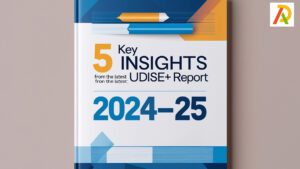Indian Wedding Dress for Men: Traditional & Modern Styles
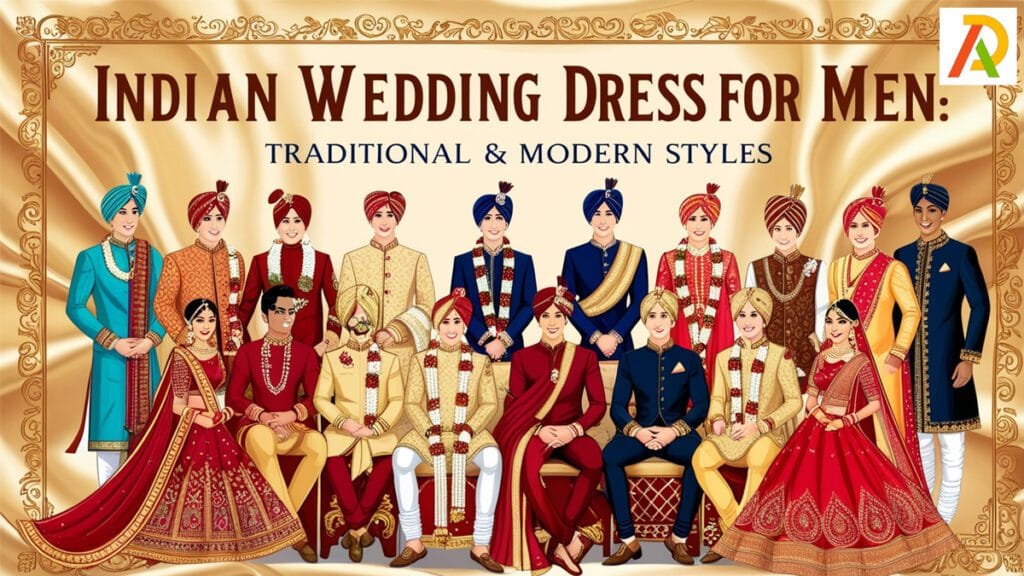
Indian weddings are known for their grandeur and rich traditions, with attire playing a crucial role, especially for grooms and male participants. The “Indian wedding dress for men” carries cultural significance and personal expression. Traditional options include the sherwani, a long, coat-like garment often embellished with intricate embroidery, typically worn with churidars or dhotis, radiating regal elegance.
This blog will explore the diverse and elegant choices available for grooms and male attendees, from traditional ensembles to contemporary Indo-Western fusion styles. We will also discuss the significance of accessories like safas, malas, and juttis, which add a final touch of sophistication. Whether you prefer a classic look or a modern twist, this guide will help you find the perfect attire for a grand Indian wedding celebration.
Traditional Attire: A Timeless Choice for Indian Grooms
Indian men’s wedding fashion beautifully showcases the country’s rich cultural heritage. Traditional attire, such as the lavish sherwani and the stylish dhoti kurta, holds significant meaning and radiates elegance. Each region in India offers its unique interpretation of wedding outfits, yet some styles have stood the test of time. These classic ensembles, typically made from luxurious fabrics and embellished with detailed embroidery, guarantee that grooms appear at their finest on their big day.
1. Sherwani: The Quintessential Groom’s Outfit
The sherwani is a popular choice for Indian grooms. It is known for its long coat-like design in the Mughal era. With its regal appeal, the sherwani is a structured outfit typically worn over a kurta and paired with churidars or dhoti pants. Many sherwanis feature intricate embroidery, zari work, or bead embellishments, making them perfect for wedding ceremonies.
Sherwanis can range from minimalist designs with subtle self-patterns to heavily embroidered styles. Some modern interpretations incorporate Indo-Western elements, showcasing asymmetrical cuts, unique button placements, and luxurious fabrics like velvet or silk. Traditionally, sherwanis are accessorized with a safa (turban), stole, and juti (traditional footwear), which adds to the groom’s elegance.
Handcrafted sherwanis with intricate embroidery and jewel embellishments are an excellent choice for grooms who want to make a statement. Some designs also feature velvet collars, brocade weaves, or pearl detailing, enhancing their luxurious appearance. Whether for a traditional or modern sherwani, this Indian Wedding Dress for Men remains a timeless favorite for Indian weddings.
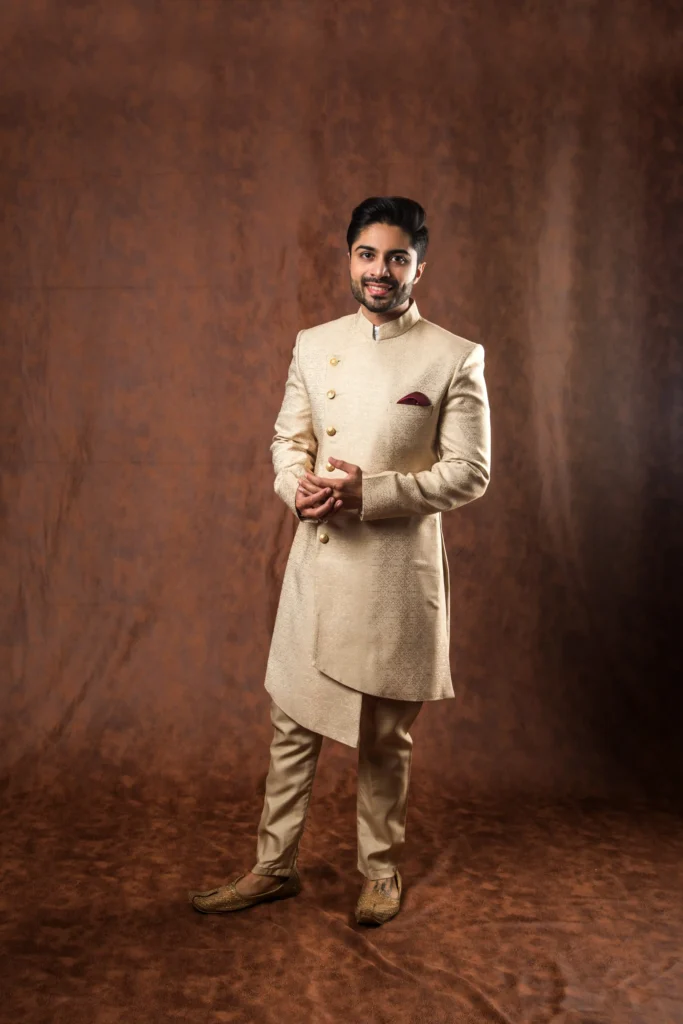
2. Kurta Pajama with Jacket: A Versatile Ensemble
The kurta pajama with a jacket is perfect for those looking for a relaxed yet stylish outfit. This combination beautifully blends traditional and modern fashion, ideal for pre-wedding events like engagement ceremonies, sangeet nights, and mehendi celebrations.
The kurta offers comfort and elegance and is typically made from luxurious fabrics such as silk, brocade, or cotton blends. The look is instantly enhanced when paired with a Nehru jacket or a richly embroidered waistcoat. The kurta-jacket set collection showcases various colors and designs, featuring delicate embroidery, mirror work, and textured fabrics.
Grooms can experiment with different jacket styles, from bandh gala (high-necked) options to asymmetrical or open-front designs. The kurta pajama with a jacket is fashionable and versatile, allowing it to be worn for other festive occasions.
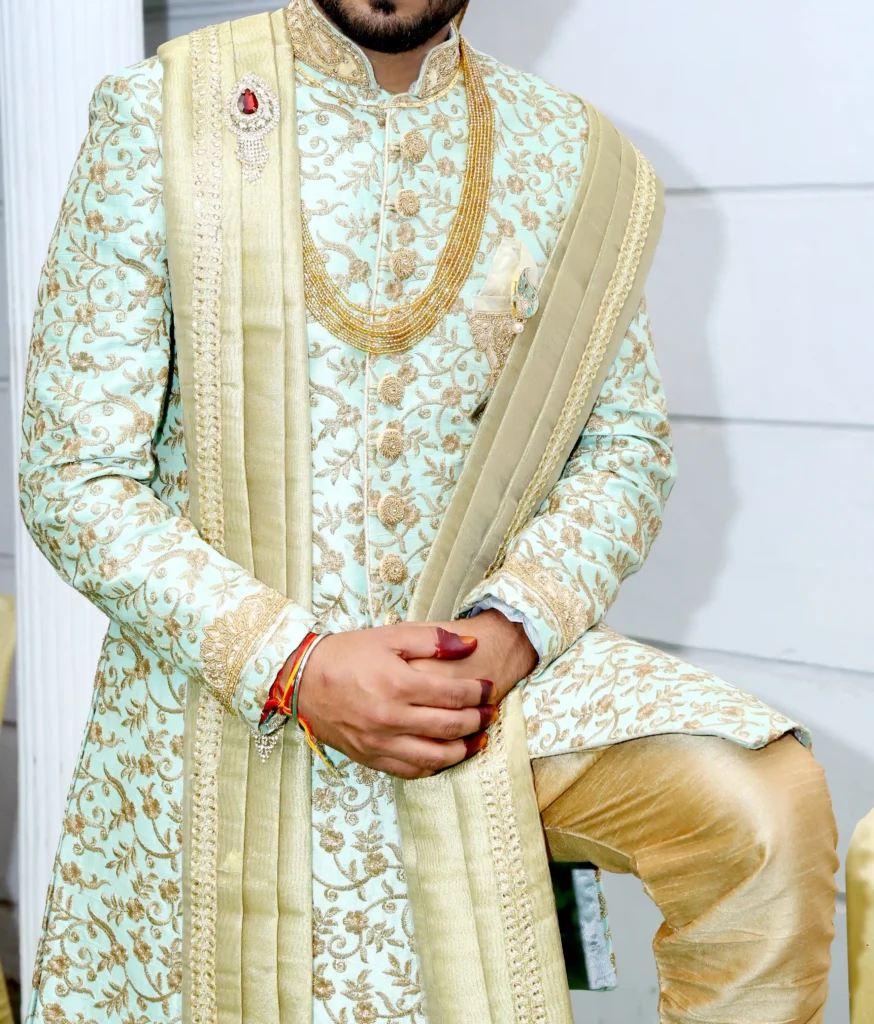
3. Dhoti Kurta: A Symbol of Cultural Heritage
The dhoti kurta is a quintessential outfit for Indian men, especially popular in South and East India. This traditional attire features a dhoti, a rectangular piece of cloth elegantly wrapped around the waist and legs, paired with a well-fitted kurta. Valued for its cultural significance and comfort, the dhoti kurta remains a favored choice for wedding ceremonies, particularly among Bengali, Tamil, and Telugu communities.
Modern dhoti kurta styles have emerged, including pre-stitched options that make wearing them more convenient. To enhance the overall appearance, grooms can accessorize the dhoti kurta with a stole, traditional footwear, and a decorative brooch.
Contemporary Fusion Wear: The Perfect Blend of Tradition and Modernity
In recent years, Indian grooms have taken a more versatile approach to wedding fashion, combining traditional elegance with contemporary flair. While classic outfits such as sherwanis and dhoti kurtas remain timeless, many modern grooms seek attire that showcases their style while still honoring their heritage. Fusion wear meets this need by blending Indian and Western elements, creating stylish and modern ensembles.
1. Indo-Western Suits: A Modern Take on Tradition
One of the most sought-after fusion wear options, Indo-Western suits combine the structured elegance of Western silhouettes with rich Indian fabrics, embroidery, and motifs. These outfits offer the perfect balance for grooms who want to look stylish while still honoring tradition.
Some of the most popular styles in Indo-Western suits include:
- Bandhgala Suits: Known for their structured, high-collared jackets, bandhgalas add a touch of sophistication. Often paired with slim-fit trousers or breeches, they create a sharp, regal appearance.
- Achkan Suits: They resemble sherwanis but are slightly shorter and have a structured fit. They are an excellent option for pre-wedding functions like sangeet or reception.
- Asymmetrical Cuts and Unique Drapes: Many modern Indo-Western suits incorporate asymmetrical button placements, layered drapes, and embroidered lapels, creating a fresh, contemporary look.
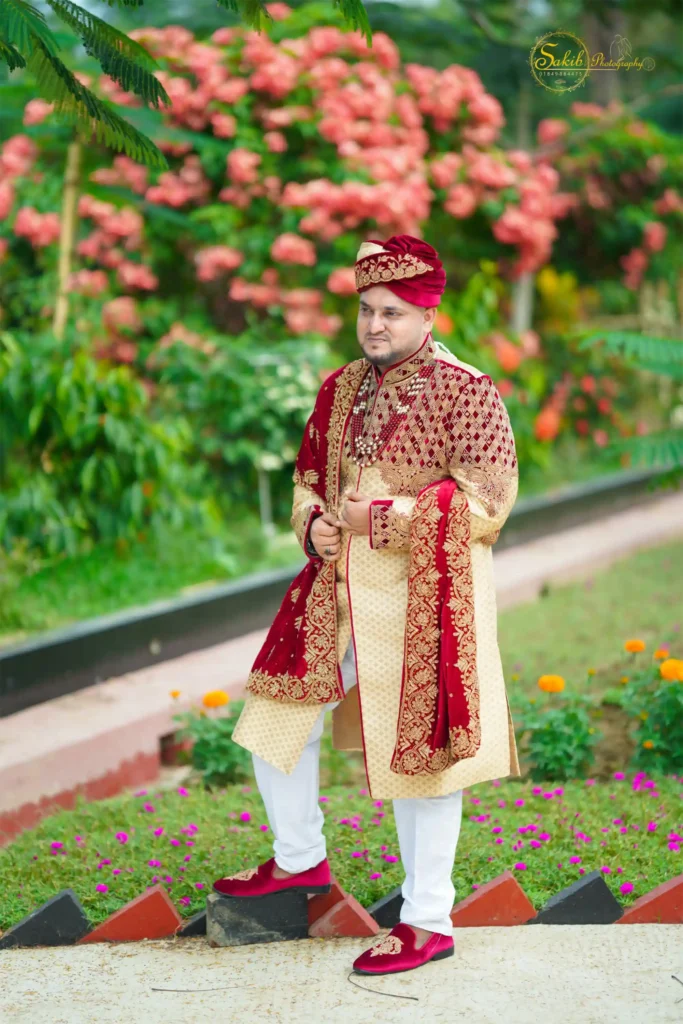
2. Jodhpuri Suits: Royalty Redefined
Jodhpuri suits, often called bandhgala suits, are rooted in the royal courts of Rajasthan and blend Western-style tailoring with traditional Indian aesthetics. Characterized by their high-necked bandhgala jackets, these suits are typically worn with trousers or jodhpuri breeches. The Jodhpuri suit radiates a sense of royalty, making it a perfect option for grooms seeking a sophisticated yet modern appearance.
What makes the Jodhpuri suit unique?
- Rich Fabrics: These suits are usually made from luxurious materials like velvet, silk, or jacquard, showcasing exquisite textures and detailed embroidery.
- Embellishments: Numerous designs include artisanal embroidery, gold threadwork, or metal buttons, enhancing their regal charm.
- Versatility: Jodhpuri suits are versatile options for weddings, receptions, and cocktail parties.
Accessorizing the Ensemble: Elevating the Groom’s Attire
Accessories are essential to a groom’s wedding attire, enhancing the overall aesthetic and adding a regal charm. While the outfit itself is crucial, the right accessories bring out the grandeur and elegance of traditional Indian wedding wear. From the safa to the juti, each element carries cultural significance and contributes to a well-coordinated and polished look.
1. Safa (Turban): A Symbol of Honor and Royalty
The safa, or turban, is one of the most iconic and symbolic accessories in Indian weddings. More than just a headpiece, it represents honor, respect, and pride. In many cultures across India, tying a safa is considered a sacred tradition, often carried out by close family members.
Choosing the right color and fabric for the safa is essential, as it should complement the Indian Wedding Dress for Men. Many grooms opt for silk, brocade, or velvet turbans, often adorned with gold embellishments, embroidery, or stone-studded kalgis (turban brooches) for added grandeur. Popular colors include:
- Red and gold – Symbolizing prosperity and tradition.
- Pastels – Modern, elegant, and subtle.
- Royal blue or deep maroon – Exuding sophistication and regality.
Read more on wedding: - Indian wedding hairstyles for long hair
- Indian wedding menu list
- Best Airbnb Wedding Venues in the USA
2. Mala (Necklace): A Statement of Elegance
Layered necklaces, or malas, are a crucial part of traditional Indian wedding attire, adding an extra dimension of luxury and refinement. Grooms often wear:
- Pearl malas – Subtle, classic, and elegant.
- Kundan or polki necklaces – Perfect for a royal touch.
- Gemstone malas – Featuring emeralds, rubies, or sapphires for an opulent appearance.
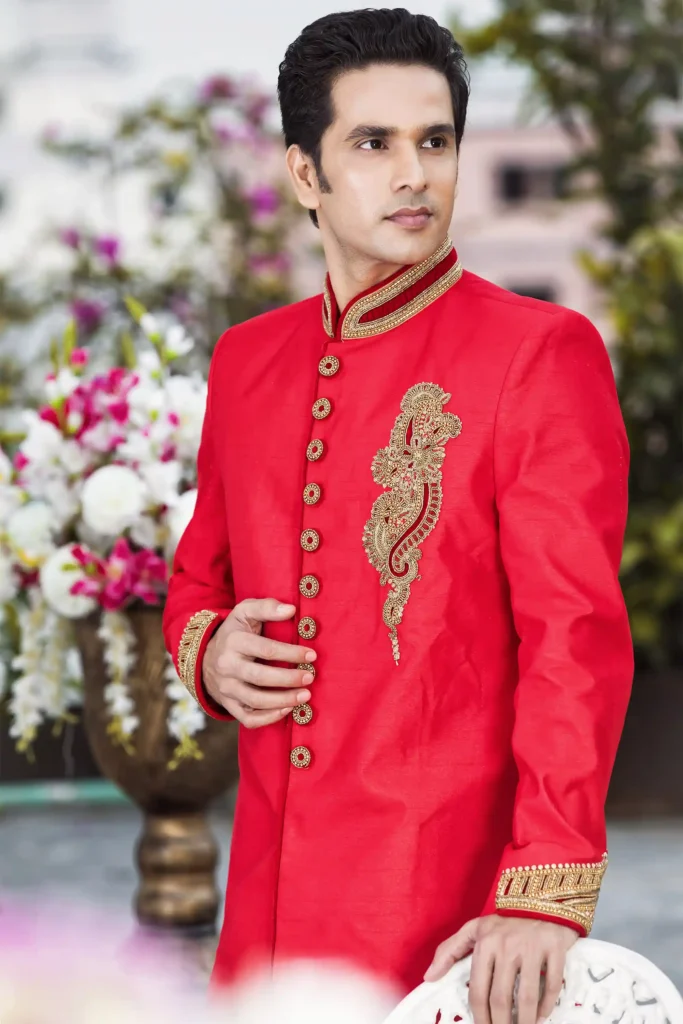
3. Juti (Traditional Footwear): Completing the Look
No groom’s attire is complete without traditional handcrafted juti, designed to match the outfit’s color and embroidery. Unlike Western shoes, jutis feature intricate handwork pointed toes, and embellishments like zari, sequins, or beads. Whether in classic gold, embroidered silk, or embellished velvet, jutis ensure the groom’s look remains cohesive and traditionally rooted.
4. Brooch: A Touch of Sophistication
A brooch, often pinned to the sherwani or safa, is a subtle yet powerful accessory. Many grooms choose bejeweled or gold-plated brooches with pearl chains, adding a regal and polished touch to their attire.
5. Dupatta or Shawl: Adding Layers of Grandeur
Draping a dupatta or shawl over the shoulder adds depth, movement, and luxury to the wedding ensemble. Made from silk, velvet, or organza, these drapes are often adorned with zari work, borders, or intricate embroidery, making them a striking yet traditional addition.
By thoughtfully choosing the right accessories, grooms can elevate their wedding attire into a masterpiece, ensuring a visually stunning look.
Indian Wedding Dress for Men: Regional Variations
India’s rich cultural heritage is beautifully reflected in its wedding attire, with each region offering distinct styles passed down through generations. From the intricate sherwanis of North India to the elegant dhoti ensembles of the South, every area has a unique take on wedding fashion, ensuring that grooms look regal and dignified on their special day.
1. South India: Timeless Simplicity and Elegance
In South India, wedding attire is deeply rooted in tradition and emphasizes simplicity, comfort, and elegance. Grooms often wear a veshti, a traditional dhoti-style silk or cotton garment wrapped around the waist. This is usually paired with an angavastram, a decorative stole draped over the shoulders, symbolizing grace and respect.
Key elements of South Indian Wedding Dress for Men:
- Fabric Choice: Silk is the preferred material, with popular varieties like Kanchipuram silk dhotis that exude luxury and tradition.
- Color Palette: White and gold are dominant, symbolizing purity and prosperity.
- Accessories: Grooms often wear a mundu (white dhoti with a gold border), For a royal touch, groomsjewelry, and a traditional headpiece (thalapa or pagadi) for a royal touch.
2. North India: The Classic Grandeur of Sherwanis and Achkans
North Indian grooms embrace sherwanis and achkans, which are heavily embroidered and often paired with churidars or dhotis. These outfits are designed to exude a sense of royalty, drawing inspiration from Mughal and Rajput styles.
Key features of North Indian wedding attire:
- Sherwani: A long, coat-like garment, often featuring zari embroidery, sequins, and brocade fabrics.
- Achkan: Similar to a sherwani but slightly shorter, with a structured fit and minimalist embellishments.
- Color Palette: Deep hues like maroon, gold, royal blue, and ivory dominate North Indian wedding fashion.
- Accessories: A safa (turban), pearl mala (necklace), and embroidered juttis complete the regal look.
States like Punjab, Uttar Pradesh, Rajasthan, and Delhi showcase a preference for these elaborate outfits, creating a striking wedding ensemble.
3. West India: A Fusion of Heritage and Modernity
Western Indian wedding fashion is a blend of tradition and contemporary influences. Grooms from Gujarat, Maharashtra, and Rajasthan often wear a dhoti with a bandhgala or angrakha-style jacket, offering a sophisticated yet traditional look.
Key elements:
- Bandhgala Suits: This versatile attire features a high-necked, structured jacket that blends Indian and British influences.
- Traditional Dhoti Kurta: Often worn in silk with gold embroidery, adding a regal touch.
- Headgear: Rajasthani and Gujarati grooms wear elaborately decorated safas and pagdis, adding a royal flair.
4. East India: The Elegance of Silk Dhoti-Kurta Ensembles
In East India, wedding attire is characterized by elegant silk dhotis and intricately embroidered kurtas. States like Bengal, Assam, and Odisha have unique wedding dress traditions that emphasize handwoven fabrics and fine craftsmanship.
Key features:
- Silk Dhoti & Kurta: Bengali grooms wear a white or cream dhoti with an embroidered panjabi (kurta), often made of tussar silk or muslin.
- Assamese Groom’s Attire: The traditional mekhela chador-inspired wedding ensemble often features unique motifs in Assamese silk.
- Accessories: A gold or pearl necklace, embroidered stole, and mojaris (traditional footwear) complete the look.
Occasion-Specific Attire: Dressing Right for Every Wedding Function
Indian weddings are multi-day celebrations with various rituals, each with significance and a dress code. Choosing the proper attire for each event ensures a well-coordinated and stylish look while honoring traditional customs.
● Engagement: A Semi-Formal Look
The engagement ceremony is the official announcement of the wedding, typically attended by close family and friends. A kurta with a Nehru jacket is ideal for this occasion, balancing elegance and comfort. Embroidered or textured Nehru jackets add a touch of sophistication, making them perfect for the semi-formal setting. Lighter hues like beige, sky blue, and pastel pink are popular.
● Sangeet: A Night of Glamour
The Sangeet is one of the most vibrant pre-wedding events, filled with music and dance performances. This occasion allows for more experimental and modern attire, such as Indo-Western outfits. Options like bandhgala jackets with dhoti pants or asymmetrical Indo-Western suits create a stylish yet comfortable look. Rich fabrics like velvet, brocade, and silk enhance the grandeur of the night.
● Haldi: A Festive Yellow Affair
The haldi ceremony is an intimate event where turmeric paste is applied to the bride and groom for good luck. A simple kurta pajama, preferably in yellow, aligns with the traditional theme. Light, breathable fabrics like cotton or linen ensure comfort during the lively and sometimes messy event.
● Reception: A Grand Finale
The wedding reception is the final event where grooms can boldly make a statement. A formal suit, tuxedo, or heavily embroidered sherwani ensures a regal appearance. Deep shades like navy blue, black, or maroon with metallic embroidery or embellishments exude sophistication.
Conclusion: Celebrating Tradition with Style
Indian Wedding Dress for Men harmoniously blends cultural heritage and contemporary fashion. Whether opting for the regal sherwani, the classic dhoti kurta, or the versatile kurta pajama with a jacket, each ensemble carries a unique charm that reflects tradition while allowing personal expression. The evolving landscape of men’s wedding fashion has also embraced Indo-Western suits and fusion wear, offering grooms a modern yet rooted approach to their wedding day look.
Beyond the outfits, accessories such as the safa, mala, juti, and brooch elevate the ensemble, adding grandeur and sophistication. Various wedding functions require distinct attire, from semi-formal engagement looks to grand reception ensembles, so grooms have endless options to curate their perfect wardrobe.
Ultimately, Indian wedding fashion is not just about dressing up—it is a celebration of heritage, craftsmanship, and personal style, ensuring that every groom looks and feels his best on his special day.
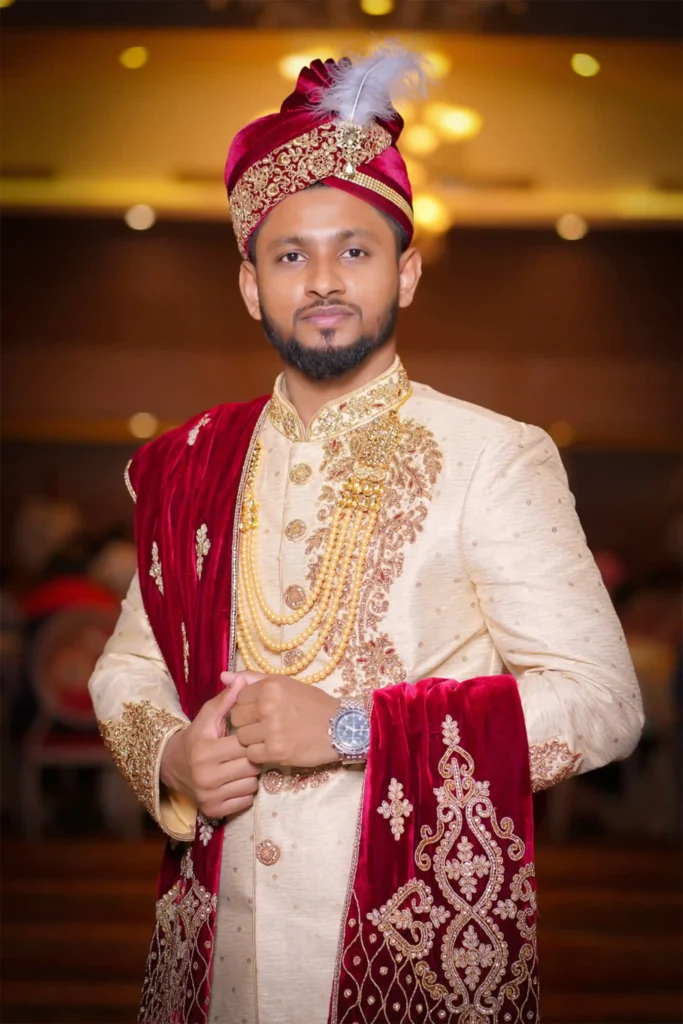
FAQs
1. What is the most traditional wedding attire for Indian grooms?
Answer: The most traditional attire for Indian grooms is the sherwani, a long, embroidered coat-like garment worn with churidar pants or a dhoti. It is often accessorized with a safa (turban), mala (necklace), and juti (traditional footwear) to complete the regal look.
2. What is the difference between a sherwani and an Indo-Western suit?
Answer: A sherwani is a heavily embroidered, traditional Indian outfit with a long coat-like design typically worn for wedding ceremonies. On the other hand, an Indo-Western suit blends Western silhouettes with Indian fabrics and embellishments. It features modern cuts, asymmetrical designs, and unique draping styles, making it a contemporary yet culturally rooted choice.
3. Can I mix and match traditional and modern styles for my wedding?
Answer: Absolutely! Many grooms today combine classic elements with modern trends. For example:
- Pair a traditional sherwani with modern jodhpuri trousers.
- Wear a bandhgala suit with embroidered ethnic motifs.
- Opt for an Indo-Western outfit with fusion draping for a contemporary yet regal look.
4. What’s the best outfit for a destination wedding?
Answer: Your outfit should match the wedding setting:
- Beach Wedding: A lightweight linen or silk kurta with an open jacket.
- Palace Wedding: A richly embroidered sherwani with regal accessories.
- Outdoor Garden Wedding: A floral or pastel Indo-Western suit for a fresh, contemporary look.
5. How can I coordinate my outfit with my bride’s attire?
Answer:
- Match the color palette by choosing a complementary shade.
- Incorporate matching embroidery or motifs for a coordinated look.
- Use accessories like safa, dupatta, or pocket square to tie both outfits together subtly.
